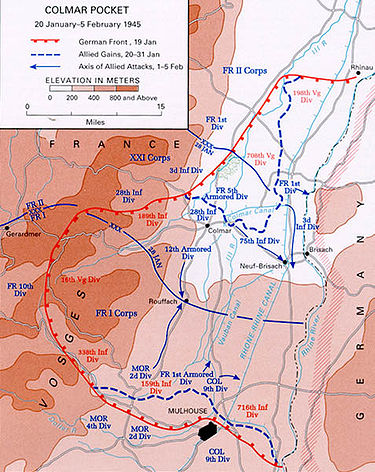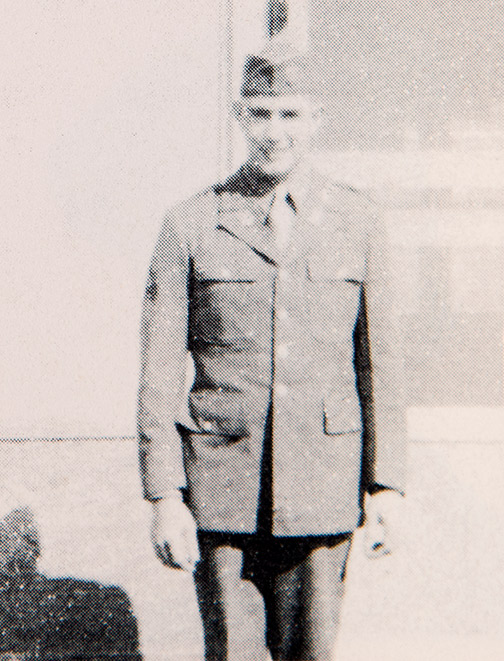Raymond J. Steere
Date of Birth: February 10, 1920
Place of Birth: Ogden, Kansas
Father and Mother’s Names: Edison Wilcox Steere, Sr. and Zoetta Mae (Bane) Steere
Date Entered Service: April 1, 1942 at Fort Riley, Kansas.
Service Branch: Army
Rank/Specialty: First Lieutenant
Service ID: 0-1311444
Division/Company/Unit info: Company C, 15th Infantry Regiment, 3d Infantry Division.
Awards and Commendations: Purple Heart, Silver Star (Posthumously), European Theatre Medal with two battle stars, Combat Infantry Badge, French Croix de Guerre and the Distinguished Unit Citation.
Riley Connection: Lived in Ogden, Kansas from 1920-1940.
Date of Death (and Age): KIA (Killed in Action) January 25, 1945 (age 24).
Place of Death: Colmar Pocket, Alsace, France.
Grave Location: Re-interred from France June 1948 at Humboldt Cemetery, Humboldt Creek, Geary Co., Kansas.
Bio: Raymond Joseph Steere was born on February 10, 1920 in Ogden, Riley Co., Kansas to Edison Wilcox Steere, Sr. and Zoetta Mae (Bane) Steere. Raymond was raised in Ogden, Kansas and attended the local schools. On April 1, 1942, Raymond joined the Army at Fort Riley, Kansas and became a 1st Lieutenant attached to Company C, 15th Infantry, 3rd Infantry Division.
On October 24, 1942, the 15th Infantry and the 3d Infantry Division sailed from Norfolk, Virginia, bound for French Morocco. For the next 31 months, the regiment fought through French North Africa, Sicily, Italy, France, and Germany.
Combat Chronicle:
The 3rd Division is the only division of the U.S. Army during World War II that fought the Axis on all European fronts, and was among the first American combat units to engage in offensive ground combat operations. Audie Murphy, the most highly decorated American soldier of the war, served with the 3rd Division. The 3rd Infantry Division saw combat in North Africa, Sicily, Italy, France, Germany and Austria for 531 consecutive days. During the war the 3rd Infantry Division consisted of the 7th, 15th and 30th Infantry Regiments, together with supporting units.
The 3rd Division, under the command of Major General Jonathan W. Anderson, after spending many months training in the United States after the Japanese attack on Pearl Harbor, first saw action during the war as a part of the Western Task Force in Operation Torch, the Allied invasion of North Africa, landing at Fedala on November 8, 1942, and captured half of French Morocco. The division remained there for the next few months and therefore took no part in the Tunisian Campaign, which came to an end in May 1943 with the surrender of almost 250,000 Axis soldiers who subsequently became prisoners of war (POWs). While there a battalion of the 30th Infantry Regiment acted as security guards during the Casablanca Conference in mid-January 1943. In late February Major General Anderson left the division and was replaced by Major General Lucian K. Truscott, Jr., who instituted a tough training regime and ensured that all ranks in the division could march five miles in one hour, and four miles an hour thereafter. The troops called it "the Truscott Trot." The division began intensive training in amphibious landing operations.
On 10 July 1943, the division made another amphibious assault landing on the Italian island of Sicily (code named Operation Husky), landing at Licata town on the beach, to west, called Torre di Gaffi and Mollarella and on the beach, to east, called Falconara. The division, serving under the command of Lieutenant General George S. Patton's U.S. Seventh Army, fought its way into Palermo before elements of the 2nd Armored Division could get there, in the process marching 90 miles in three days, and raced on to capture Messina on 17 August, thus ending the brief Sicilian campaign, where the division had a short rest to absorb replacements. During the campaign the 3rd Division gained a reputation as one of the best divisions in the Seventh Army.
Eight days after the Allied invasion of mainland Italy, on 18 September 1943, the 3rd Division came ashore at Salerno, where they came under the command of VI Corps, under Major General Ernest J. Dawley who was replaced two days later by Major General John P. Lucas (who had commanded the division from September 1941 to March 1942). The corps was part of Lieutenant General Mark W. Clark's U.S. Fifth Army. The 3rd Division was destined to see some of the fiercest and toughest fighting of the war thus far, serving on the Italian Front. Seeing intensive action along the way, the division drove to and across the Volturno River by October 1943, and then to Monte Cassino, where the Battle of Monte Cassino would later be fought, before, with the rest of the 15th Army Group, being held up at the Winter Line (also known as the Gustav Line). In mid-November the division, after spearheading the Fifth Army's advance and suffering heavy casualties during the past few weeks, was relieved by the 36th Infantry Division and pulled out of the line to rest and absorb replacements, coming under the command of Major General Geoffrey Keyes' II Corps. The division remained out of action until late December.
After a brief rest, the division was part of the amphibious landing at Anzio, code named Operation Shingle, on 22 January 1944, still as part of VI Corps, and serving alongside the British 1st Infantry Division and other units. It would remain there for just under four months in a toe-hold against numerous furious German counterattacks, and enduring trench warfare similar to that suffered on the Western Front during World War I. On 29 February 1944, the 3rd Division fought off an attack by three German divisions, who fell back with heavy losses two days later. In a single day of combat at Anzio, the 3rd Infantry Division suffered more than 900 casualties, the most of any American division on one day in World War II. The division's former commander, Major General Lucas, was replaced as commander of VI Corps by the 3rd Division's commander, Major General Truscott. He was replaced in command of the 3rd Division by Brigadier General John W. "Iron Mike" O'Daniel, previously the assistant division commander (ADC) and a distinguished World War I veteran.
In late May, VI Corps broke out of the Anzio beachhead in Operation Diadem with the 3rd Division in the main thrust. Instead of defeating the Germans, Lieutenant General Clark, the Fifth Army commander, disobeying orders from General Sir Harold Alexander, Commander-in-Chief (C-in-C) of the Allied Armies in Italy (formerly the 15th Army Group), sent the division on to the Italian capital of Rome. This allowed the majority of the German 10th Army, which would otherwise have been trapped, to escape, thus prolonging the campaign in Italy. The division was then removed from the front line and went into training for the Operation Dragoon, the Allied invasion of Southern France.
On 15 August 1944, D-Day for Dragoon, the division, still under VI Corps command but now under the U.S. Seventh Army, landed at St. Tropez, advanced up the Rhone Valley, through the Vosges Mountains, and reached the Rhine at Strasbourg, 26–27 November 1944. After maintaining defensive positions it took part in clearing the Colmar Pocket on 23 January, 1945.
Formation of the Pocket:
A German bridgehead on the west bank of the Rhine 40 miles (65 km) long and 30 miles (50 km) deep was formed in November 1944 when the German defenses in the Vosges Mountains collapsed under the pressure of an offensive by the U.S. 6th Army Group.[4] General Jean de Lattre de Tassigny's French First Army forced the Belfort Gap and destroyed the German IV Luftwaffe Korps near the town of Burnhaupt in the southern Vosges Mountains. Soon thereafter, French forces reached the Rhine in the region north of the Swiss border between Mulhouse and Basel. Likewise, in the northern Vosges Mountains, the French 2nd Armored Division spearheaded a U.S. Seventh Army advance, forced the Saverne Gap, and drove to the Rhine, liberating Strasbourg on 23 November 1944. The effect of these two advances was to collapse the German presence in southern Alsace west of the Rhine to a semi-circular-shaped bridgehead centered on the town of Colmar that came to be known as the Colmar Pocket.
The Allied attack in the north:
General Joseph de Goislard de Monsabert's II e Corps d'Armée launched its attack on 22–23 January. The attacking units were the U.S. 3rd Infantry Division and the French 1st March Infantry Division. South of the 3rd Division, the U.S. 28th Infantry Division defended its sector of the front. In reserve was the French 2nd Armored Division.
The information available for this veteran is incomplete. We would like to include as much information about all our veterans as possible, so if you or someone you know has any additional information we encourage you to contact us at: peacememorialmanhattan@gmail.com. Thank you for your support.

